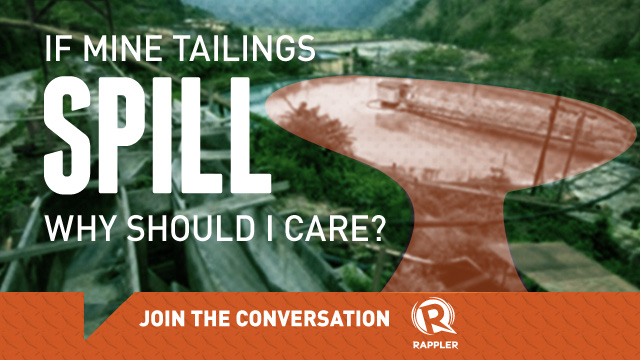SUMMARY
This is AI generated summarization, which may have errors. For context, always refer to the full article.

MANILA, Philippines – Representatives from the “poster boy” of the advocates of responsible mining and critics of the extractive industry faced off on Twitter following recent tailings leak incidents in Benguet province.
Using the hashtag #WhyMining, the online discussion on mining and the environment hosted by Rappler trended locally on Twitter on Friday, September 7.
The Twitter-based conversation entitled “If a mine spills, why should I care?” took off from the weather-challenged waste spillage at the Padcal mine’s tailings pond of Philex Mining Corp, the country’s largest mining company.
The incidents of mine leaks happened amid a porous political and business environment in the Philippines. Industry players and environmental and interest groups are currently in consultation meetings before the Aquino government finalizes its rules and regulations this September on the recently released Executive Order 79, which sets the policy on mining activities.
Sins of past
The Padcal incident spilled nearly 5 million cubic meters of sediments from the only operating tailings pond of Philex in Benguet province.
Amid intense rainfall due to typhoons and monsoon rain in August, the tailings pond facility leaked at least 4 times in just one month.
The spill cast another shadow on a industry that has been haunted by episodes of mining disasters in the country.
@rapplerdotcom @lalarimando #Whymining padcak mine spill is affirmation of the sins of the past still in the making. history unfolds
— Rod Galicha (@kalikasan101) September 7, 2012
In March 1996, the country’s worst mining disaster occurred in the province of Marinduque when Marcopper Mining Corp.’s open pit fractured, leaking nearly 3 million cubic meters of mine tailings into the 26-kilometer Boac River.
About a decade after, catastrophic toxic spills in the province of Albay were unleashed from the Lafayette Mining Company’s Rapu-Rapu Polymetallic Project, considered the biggest mining operation at that time.
It took several days and published dramatic pictures of the effects of these spills before these reached national consciousness.
The Padcal incident, though seemingly better communicated than the previous Marcopper and Rapu-Rapu incidents, is the latest in the list.
#WhyMining Philex is currently the largest listed mining firm n Phil. In various industry fora, twas poster firm 4 #ResponsibleMining”
— Abby Pimentel (@catseyegail) September 7, 2012
Kalikasan Partylist, an environmentalist interest group which participated in the Twitter discussion, called the Padcal spillage a disaster.
Indeed, mine wastes don’t have to be toxic to affect river health. 5M m.tons of waste = 2,000 olympic pools. #WhyMining
— Kalikasan Partylist (@KalikasanParty) September 7, 2012
Investigating the spill
During the Twitter discussion, a Philex officer explained the several measures it has taken to address the spillage and its effects.
@voltairetupaz 1. Condemnation of the affected penstock. 2. thorough planning for a long-term solution – our commitment is that we won’t..
— Rochelle Hilario (@walk_the_talk) September 7, 2012
@voltairetupaz … we won’t operate again until integrity of the dam is fully ensured.
— Rochelle Hilario (@walk_the_talk) September 7, 2012
@voltairetupaz 3. daily monitoring of water quality in the pond and the tributaries.
— Rochelle Hilario (@walk_the_talk) September 7, 2012
Philex also claimed it designed an ecosystems approach to aquatic, terrestrial and social rehabilation of the affected area.
After Philex reported the leakage, the Mines and Geosciences Bureau (MGB) issued to Philex a cease operation order.
But Twitter user Phillip Fullon, head of policy review and research at the Office of the Presidential Adviser for Environmental Protection, suggested the government should cancel other permits of the mining company if it cannot address the disaster.
@rapplerdotcom #WhyMining if a firm cannot fix a disaster from their mine, govt should cancel their other existing permits
— Phillip Fullon (@phillipfullon) September 7, 2012
The MGB is yet to release next week the result of the investigation it conducted in the aftermath of the spill. It has already dispatched two teams to ascertain the environmental impact and to determine civil and criminal liabilities of Philex.
According to Philex, bad weather in the area slowed down the probe being conducted by engineers & tailings dam experts.
But Kalikasan Partylist distrusted the investigation saying that it will conduct its own investigation in partnership with local stakeholders.
We are planning alongside the CPA to mount an investigation. Based on MGB’s statements re: d issue, we can’t expect impartiality. #WhyMining
— Kalikasan Partylist (@KalikasanParty) September 7, 2012
[We are planning alongside the Cordillera Peoples Alliance to mount an investigation. Based on MGB’s statements regarding the issue, we can’t expect impartiality. #WhyMining]
However, Twitter user JP Alipio, executive director of Cordillera Conservation Trust, praised Philex for at least being transparent about the spill.
.@voltairetupaz #whymining it’s a good move on philex mines part to be reporting the disaster. It is new to the industry to be transparent
— JP Alipio (@JPAlipio) September 7, 2012
Cost of destruction
Alipio, however, raised the issue of the value of damages Philex should pay, arguing that polluter fees are grossly undervalued and do not reflect ecological costs.
@voltairetupaz the law normally has a fixed amount based on spillage. Calculating ecological damage will entail multi year analysis of
— JP Alipio (@JPAlipio) September 7, 2012
@voltairetupaz of effects including damage to flora and fauna plus even coastal areas marine habitats and Lost of use of the river.
— JP Alipio (@JPAlipio) September 7, 2012
Under the Mining Act of 1995, the mining company could be fined at least P325 million for the nearly 5 million cubic meters of sediments that spilled.
Other Twitter users questioned how the economic benefits of mining do not trickle down to communities hosting mining companies.
Diane Estephanie, a forester, raised her perceived inequality in the economic benefits of mining.
@missrayz @forestercary problema sa mining eh hindi yung mismong komunidad ang nakikinabang kundi yung mga taga makati! #WhyMining
— Diane Estephanie (@nadinesoinlove) September 7, 2012
Rod Galicham, Philippine District Manager of President Al Gore’s The Climate Reality Project, stressed that the mining sector has the highest poverty incidence (48.7%) among sectors in the country.
#Whymining Bataraza in Palawan where Rio Tuba mine is in 30 yrs has poverty incidence double (53%) the nat’l rate (26%).
— Rod Galicha (@kalikasan101) September 7, 2012
Is ‘responsible mining’ possible?
Meanwhile, netizens debate on long term solutions, particularly on what policy to adopt after the Philex mine waste spill.
#WhyMining There issuch thing as responsible mining. There are success stories in Canada, Australia and other countries.
— MarjorieTeresaPerez (@joyetteperez) September 7, 2012
We do need mining, but strict regulations must be ensured so that the envt won’t be compromised. Responsible mining is possible #WhyMining
— KC Oteyza (@kc_oteyza) September 7, 2012
There are many alternatives to the Philex-style mining regime. We are pushing for the People’s Mining BIll ow.ly/dxdon #WhyMining
— Kalikasan Partylist (@KalikasanParty) September 7, 2012
Community-based small-scale mining is sustainable and empowering, not to some corp., but to the people the industry should serve.#WhyMining
— Guilo Fajardo (@guiloboi) September 7, 2012
#WhyMining when the country’s biggest gold producer cannot even ensure the safety of its mining sites. Let’s err on the side of caution.
— Froilan Grate (@GreenMinds) September 7, 2012
– Rappler.com
For the existing mining contracts in the Philippines, view this #WhyMining map.
How does mining affect you? Are you pro or against mining? Engage, discuss & take a stand! Visit Rappler’s #WhyMining microsite for the latest stories on issues affecting the mining sector. Join the conversation by emailing whymining@rappler.com your views on the issue.
For other views on mining, read:
| Yes to Mining | No to Mining |
More on #WhyMining:
- Shaping the future of mining
- EO: No new mining contracts
- The Mining EO: A mixed bag
- Mining E.O. not perfect, but very good
- CONVERSATIONS: What are your thoughts on the mining EO? #WhyMining
- Mining E.O. pits gov’t vs local execs
- Correcting lies and disinformation
- Stand for the environment
- How can mining work for Philippines?
- Mining is a social justice issue
- REPLAY: #WHYMINING
Add a comment
How does this make you feel?





There are no comments yet. Add your comment to start the conversation.